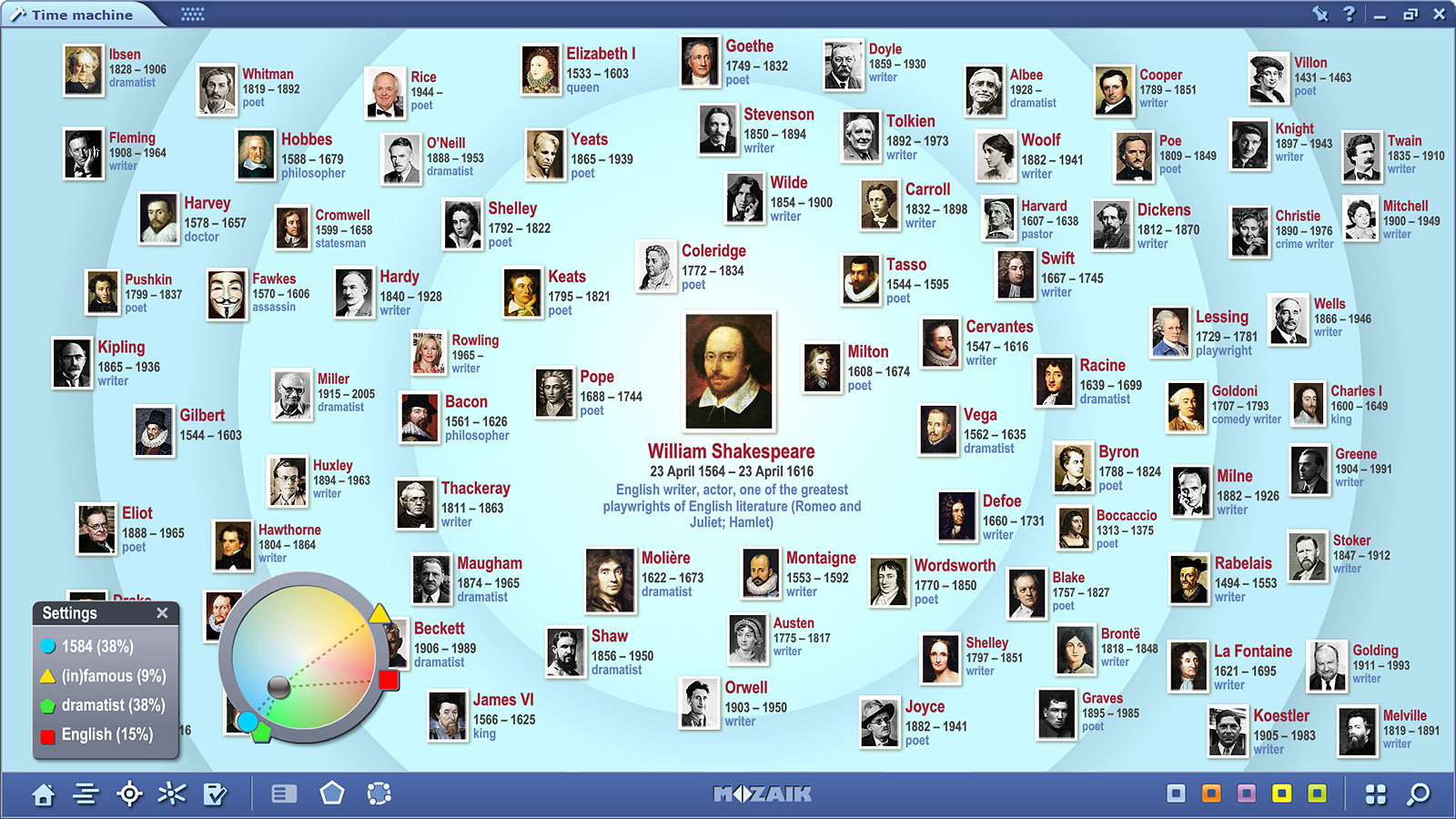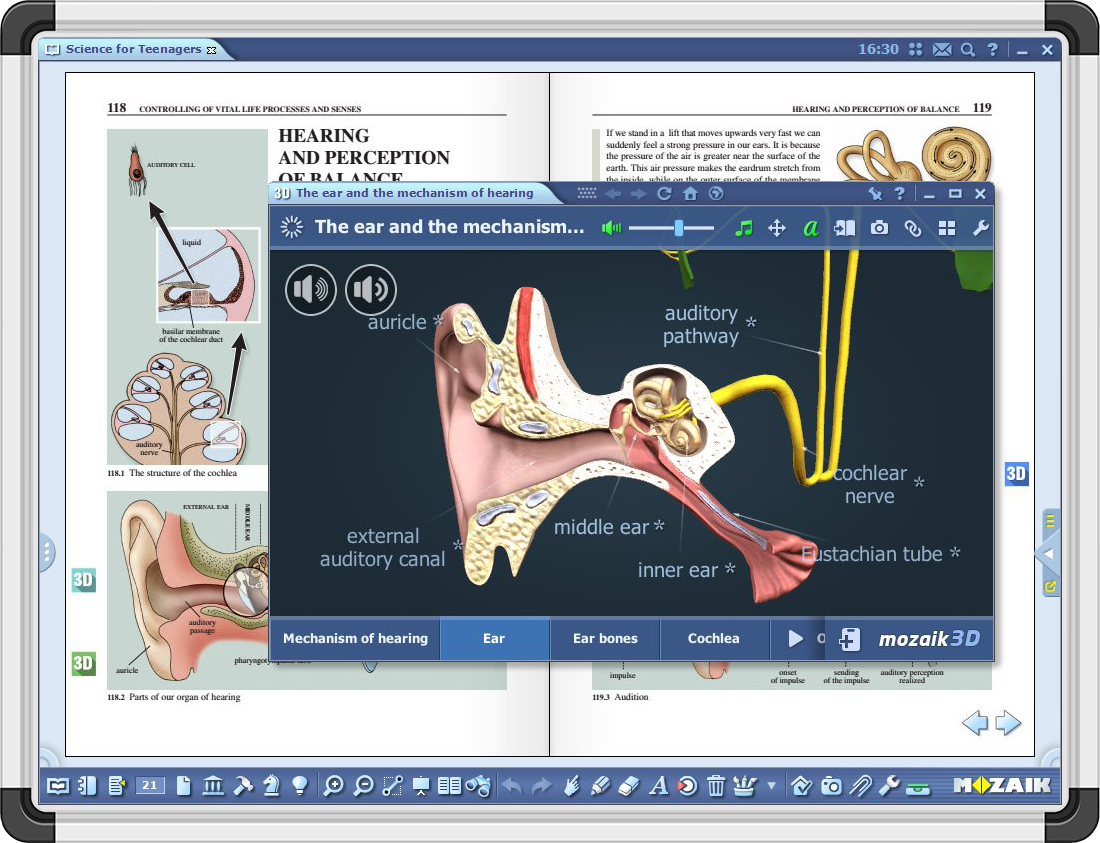 From the perspective of teachers, with all their responsibilities, there can be an ambivalent attitude toward incorporating new technologies into the classroom. I know because I am a teacher. I have been in the meetings and seen the frustrated faces of those thinking: “Not again. Another big idea from the administration which will only mean more work for me…” or “There goes my lunch break!” However, with mozaBook and mozaWeb there is no need to reinvent the wheel. With our simple drag and drop function, you can seamlessly integrate your existing lesson plans onto our platform and transform them into exciting, interactive publications or presentations. If you have a lesson plan in PDF or pptx. format, which is tried, tested and effective, you can simply upload the file onto our software and begin using mozaBook and mozaWeb to supplement your lessons.
From the perspective of teachers, with all their responsibilities, there can be an ambivalent attitude toward incorporating new technologies into the classroom. I know because I am a teacher. I have been in the meetings and seen the frustrated faces of those thinking: “Not again. Another big idea from the administration which will only mean more work for me…” or “There goes my lunch break!” However, with mozaBook and mozaWeb there is no need to reinvent the wheel. With our simple drag and drop function, you can seamlessly integrate your existing lesson plans onto our platform and transform them into exciting, interactive publications or presentations. If you have a lesson plan in PDF or pptx. format, which is tried, tested and effective, you can simply upload the file onto our software and begin using mozaBook and mozaWeb to supplement your lessons.
Each student acquires information differently; be it visually, verbally, via movement or tactile means. Our software facilitates differentiated instruction by presenting each new concept in a variety of modalities and gives you back the command of your classroom. Not every student is engaged in a lesson simply by auditory means. Does this mean teachers should stop speaking? Of course not… However, when you are standing in front of a visual learner, lecturing about how an aqueduct works, it is no wonder that they are looking out the window for stimulation as you’re speaking. 
Simply lecturing to a visual learner is no different than not speaking to an auditory learner. We need to speak their language in order to engage them in our ideas. They need to see the water wheel and aqueduct! For instance, here is our 3D animation of Syrian water wheels from the 13th century. Two anticipated questions regarding this concept are 1) What makes the wheel move? 2) How does the water not spill from the moving buckets? Don’t simply explain these phenomena, allow your students to see the damming process and the effect of kinetic energy in action. Show them the buckets releasing the water only at the top in order to demonstrate this elegant, yet simple design. Allow your students the benefit of direct experience rather than forcing them to reinvent the wheel in their own minds! They need to watch it work in order to understand its purpose, relevance and significance.
Visual learners convert words into pictures in their minds. While they are more skilled at this than most, it requires a lot of energy and they can tire easily. With Mozaik’s software, you can give your students a break and demonstrate important concepts with one of our 3D drawings or photos from our digital library. You will see your visual learners perk up and their eyes get big as you show them one of our 3D drawings, because our 3D pictures are so real, they practically jump off the screen and grab your student’s attention. And that’s the point, your students will love it. When students are engaged, they are learning.
All students learn by doing. Allow them the opportunity to reinforce what was learned by playing one of our engaging and interactive games. The focus of a professional development seminar that I attended on solidifying skill mastery showed that students must practice a skill 7 times, on average, in order to obtain mastery of that skill. Therefore, practice really does make perfect.
As our understanding of the educational process evolves, we realize where our approach to teaching and understanding of the learning process had been lacking. When students are engaged, they are learning. When students are learning, they aren’t being disruptive. When students aren’t disruptive, but rather focused on the lesson, the teacher has the freedom to address the content and actually teach. The more modalities you can present to your students, the higher percentage of them will be engaged in the lesson and the happier a teacher, you will be.
With the functionality of Mozaik’s software, you can address the variety of your student’s understanding and play to their strengths rather than the conventional ‘one size fits all’ approach to teaching.
Do you have the perfect lesson to teach phonics to young readers? Great! With a few clicks you can add it to our software and begin the process of making our software work for you by adding customized, interactive letter cards or random exercises to your favorite phonics lesson. It’s time to make phonics phun. Simply import your lesson and you can add 3D models, cool exercises or interactive games from our media library. Not only that, but with Mozaik, collaboration is a cinch! With our software, you can upload and share your favorite lesson plans with your colleagues or upload them on mozaWeb so your students can practice at home with their parents. We want teachers to be able to make technology work for them in the classroom, not the other way around. This is why we also offer an incredibly user-friendly, easy-to-use platform (essentially, your grandma could use it), and even offer to train teachers in using our software!
At Mozaik Education, we believe that technology is meant to make the teacher’s life easier, while simultaneously making the lessons more engaging, interactive, and effective for your students. We know how difficult teaching is. Many of us are teachers. Our goal at Mozaik Education is to make your life better and give you the most benefit from the software, without ever missing a lunch break.
We think our 3D scenes are already cool, but today we’d like to announce it to the world: our 3D models just got even more amazing!
Every one of the interactive scenes which include the Walk feature, available on mozaWeb, have entered the world of virtual reality. More than 60 3D scenes can now be used with a virtual reality headset through the new mozaWeb 3D viewer. Download the mozaWeb 3D viewer to your Android smartphone from Google Play. The iOS application is also available on the App Store.
See for yourself: open one of your favorite 3D models, open the Walk feature, denoted by the walking man icon. A small icon of VR glasses will appear. Just click on that and place the phone in your VR headset. Then have a walk around! Just look down towards your feet to start and stop the movement.
Don’t have a favorite model in mind? Here are a few of our team’s favorites. (Once you've downloaded the app, these links will automatically open the app) :
Medieval inhabited bridge (London Bridge, 16th century)
The city of Babylon (6th century BC)
Viking stave church (Borgund, 13th century)
Nikola Tesla's laboratory (Shoreham, US)
Any type of Virtual Reality headset will work - you don’t have to spend a lot of money for a fancy pair of glasses to walk around and explore a new world. Everyone in the business development department has tried it and with great response! We hope you’ll enjoy it as much as we do.
We are developing this feature for every 3D scene that we have so stay tuned. Soon you’ll be able to use your VR headset for every type of animated model.
The ability to create a concise, well designed, and persuasive presentation is a skill that is hard to overestimate in the modern world. In fact, success in some business roles is almost entirely up to one’s presentation skills. I personally spend a fair amount of time here at Mozaik making presentations for our Business partners from all over the world, and know very well that a good presentation can take you a long way.
By now I feel that I can comfortably create and perform a good presentation, but achieving this state took me quite a while. I very well remember my numerous fiascos as a presenter, which I should be honest had as much to do with lack of preparation as with lack of experience. I naturally improved over time, but I still feel that if I had taken a formal presentation skills course at school it would save me quite a bit of trouble and anxiety. Don’t take me wrong, I am not saying that schools are totally failing at teaching students how to make presentations. I have gone through various education systems in different countries and should say that many of my teachers dedicated quite a lot of hours to listen to oral reports by students. What I was not taught, however, was how to create a good presentation using modern technology, and how to deliver my message in a convincing way. Nor was I ever really given feedback on the way I delivered the message. Instead the focus was only on the quality of research I performed to get the information that was required to create the presentation. I was doing a lot of presenting during my school years, but it never seriously crossed my mind that presentation skills is something I should give a lot of my attention to. Thus my argument is not that more school hours should be dedicated to teaching presentation skills, but rather that the way they are taught, especially taught in high school should be revised.
Don’t take me wrong, I am not saying that schools are totally failing at teaching students how to make presentations. I have gone through various education systems in different countries and should say that many of my teachers dedicated quite a lot of hours to listen to oral reports by students. What I was not taught, however, was how to create a good presentation using modern technology, and how to deliver my message in a convincing way. Nor was I ever really given feedback on the way I delivered the message. Instead the focus was only on the quality of research I performed to get the information that was required to create the presentation. I was doing a lot of presenting during my school years, but it never seriously crossed my mind that presentation skills is something I should give a lot of my attention to. Thus my argument is not that more school hours should be dedicated to teaching presentation skills, but rather that the way they are taught, especially taught in high school should be revised.
It is important to teach students to create a wholesome presentation that is enjoyable to listen to and leaves the audience with the right questions and conclusions. The type of a high quality presentation everyone is so used to watching on TED Talks for inspiration. Story-telling techniques have already conquered the business world and it is about the time they are introduced into the classroom which is a perfect place for them not only to be used by teachers, but also to be taught to students.
We are big fans of presentation skills here at Mozaik Education, we even created this awesome educational presentation software called mozaBook that is designed specifically to make it easier for the teachers to make truly impressive presentations (or lessons, as we are used to calling them in the educational world) for the students. The version of mozaBook for home use, called mozaBook Personal, was created to give students an opportunity to prepare high quality presentations at home and present them to the class during the lesson or share them online.
The technology has already made it possible to transform students into presentation gurus and now it is up to the teachers to use this technology in the classroom.
Download a free trial version of mozaBook Multilang and discover the advanced presentation tools that were created specifically for educational purposes. Nowhere else will you find a presentation software that comes together with a huge package of educational 3Ds and videos at no extra cost!
It is almost universally accepted that History is one of the core subjects taught at school. Studying and knowing history is often seen as a stepping point for getting into a more specialised Humanities courses at a university level. In many countries History is a compulsory exam for those who want to go into studying Law, Economics, Politics, International Relations, Sociology, Psychology, History of Art etc.
However, according to different studies only 7% of American school students age 13-17 and 12% of American high school students reported that History and Social Studies were their favourite subjects. This makes History approximately three times less popular among American students than Maths. In the UK, where school education is much more specialised than in the US, moderate love for History is illustrated by the percentage of sixth form students who choose to study this subject. Around 11% of British students took History A-levels in 2009-10, which made History the 6th most popular subject overall and the 3rd most popular humanities subject among British high school students. Although I do find this lack of interest in History striking, I realise that it is not lack of interest from students, but rather the way we teach History at school, that presents a real challenge. History can be extremely interesting, but it can also be extremely dull, especially when it is turned into the endless memorization of dates, that are often taken out of the wider historical context.
Although I do find this lack of interest in History striking, I realise that it is not lack of interest from students, but rather the way we teach History at school, that presents a real challenge. History can be extremely interesting, but it can also be extremely dull, especially when it is turned into the endless memorization of dates, that are often taken out of the wider historical context.
Here at Mozaik we are passionate about History and really want this wonderful subject to flourish in classrooms all over the world. One of the ways we are hoping our software can inspire students to learn history is our absolutely unique educational tool called “Time Machine”. Time Machine is designed to help students make connections between historical personalities according to their nationality, profession, date of birth and (in)famousness. Time machine includes a huge database of historical personalities that is not only regularly updated but is also customised for the local curriculum of your country. It also includes direct links to Wikipedia articles about every historical personality that is included into the database. As most of our educational tools, Time Machine has an inbuilt test function, that lets users test their knowledge of historical personalities. Users can choose from six different test modes that include a huge database of preset questions about chosen sets of historical personalities.
Time machine includes a huge database of historical personalities that is not only regularly updated but is also customised for the local curriculum of your country. It also includes direct links to Wikipedia articles about every historical personality that is included into the database. As most of our educational tools, Time Machine has an inbuilt test function, that lets users test their knowledge of historical personalities. Users can choose from six different test modes that include a huge database of preset questions about chosen sets of historical personalities. The idea behind the Time Machine educational tool is simple. We wanted to create an interactive educational resource that would show that historical connections are built on much more than just dates. Studying history is one of the best ways to develop logical thinking and learn to build complex connections between separate blocks of information. Time Machine is one of the ways to illustrate this power of History.
The idea behind the Time Machine educational tool is simple. We wanted to create an interactive educational resource that would show that historical connections are built on much more than just dates. Studying history is one of the best ways to develop logical thinking and learn to build complex connections between separate blocks of information. Time Machine is one of the ways to illustrate this power of History. Register on mozaWeb to try Time Machine for yourself, or access the tool in mozaBook. If you'd like to know more about Mozaik's tools for history, read our post about “Hall of Fame,” another great tool in the mozaWeb and mozaBook library.
Register on mozaWeb to try Time Machine for yourself, or access the tool in mozaBook. If you'd like to know more about Mozaik's tools for history, read our post about “Hall of Fame,” another great tool in the mozaWeb and mozaBook library.
The third dimension is the best dimension! 3D holograms, images, and now printing- 3D is a way to view things that has continued to fascinate us for decades and still today shows so much potential in a variety of industries. This post is going to explore the benefits of using interactive 3D models in the classroom.
First of all, I’d like you to think of 3D models simply as a teaching resource that can be used in a variety of subjects. Typically, what first comes to mind is the use of 3D resources in the sciences - anatomy, biology, geography - but it’s possible to use them for history classes, mathematics, literature, or even in discussions with students about current news events.

The evolution of the Mozaik 3D
3D is a very important part of the mozaLearn digital education system. Originally the type of 3D models (created by the development company Rendernet were created for visual design, construction, real estate and advertising, but the developers at Rendernet saw a lot of potential for their models in the field of education. We started out about 7 years ago with a modest number of models, 10 to be exact. The developer and animator team grew, and so did their capacity to produce more models. Eventually Mozaik and Rendernet joined forces and today our catalog of 3Ds has grown to 1,097 with no sign of stopping!
Our models have come a long way in every aspect, from design to content to capabilities. They have also come to life in new forms! Some of our individual 3D models are now available on the iOS App Store and Google Play for Android to download and use directly on your smartphone or tablet.

About their use in pedagogy
Let’s take a biology class for example. A teacher can introduce a new animal with photos or a video, start some discussions about its habitats and habits and then use a 3D model to go further, exploring the animal’s anatomy in detail. The end result is a deeper understanding of the animal with the added benefit of keeping students’ attention by using several different learning sources.
A similar strategy can work for all subjects, chemistry is my next example. If a chemistry teacher would like to introduce a new molecule, he or she can send 3D models of the molecules to all students’ tablets, so they can explore the structure in an interactive manner. Afterwards, the teacher can show a video experiment or conduct an experiment in his/her lab, so that students can take the next steps to understand the molecule’s chemical interactions.
How about history? Teach your students about ancient cultures by asking students to explore the Wonders of the Ancient World 3D model and watch the video. After asking some questions about the ancient structures, give the fun task of asking students to open the Walk function in the City of Babylon 3D and explore the walkway.
Most pupils are interested in learning about their own body and about how it works. We can project videos and use wall boards, drawings and photos meaning there are unlimited possibilities for visualizing these topics during lessons. When the opportunity arises we can also make observations relevant to lab practices, such as dissections, using a microscope, etc.
When we are interested in showing tissues, more specifically human blood, we always face the difficulty of taking microscopic photos of thin sections, of preparations; consequently pupils have difficulty recognizing tissues in space, or they are not even able to perceive how a tissue works. These problems can be solved with the help of a 3D animation made about human blood.
During the opening scene we get inside the blood flow where the blood components and their movement are represented. We can rotate it, making it more lifelike and so we feel like real viewers. Tip: Let's discuss it with pupils by how many times we should shrink ourselves to be able to observe blood flow this way.






